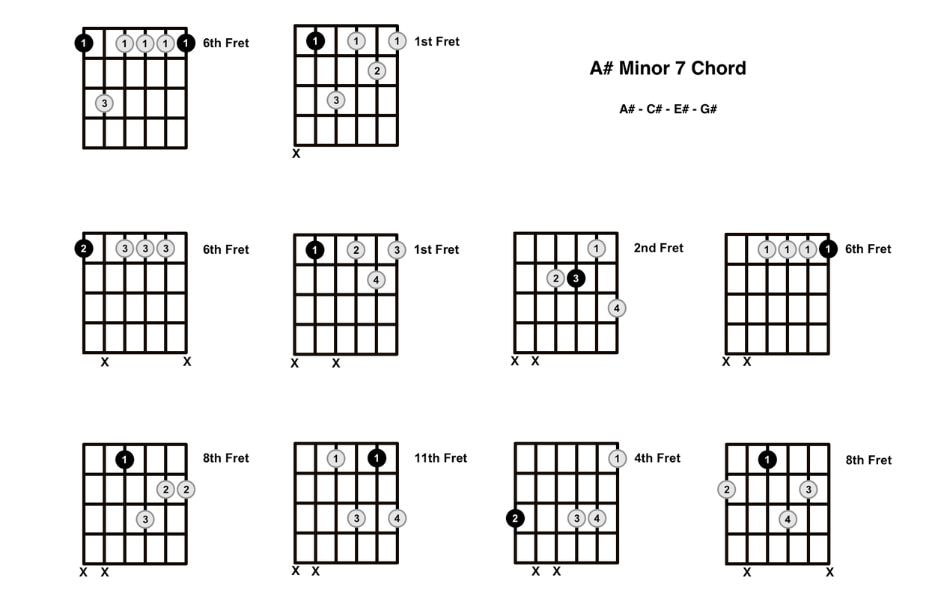Get ready to unlock the enchanting sounds of the A minor 7 guitar chord, understand its structure, and grasp the finger positioning required to play it confidently. By the end of this guide, you’ll not only be strumming the A Minor 7 chord but also integrating it into your practice sessions and musical endeavors.
Contents
Understand A minor 7 guitar chord
If you’ve got the Am chord under your belt, mastering the Am7 chord will come naturally! Consider the Am7 chord as a simplified version of the A minor chord but with a delightful twist. Both chords are typically played in Standard Open E tuning and share similar note patterns, with a subtle yet significant distinction.
The Am7 chord only alters one note, but this alteration profoundly impacts the chord’s tonal character. While the A minor chord consists of the notes A, E, A, C, E, the Am7 chord introduces a subtle change in the form of G, giving us A, E, G, C, E. (Am7 simply swaps the “A” for an open “G”).
To play the Am7, start by placing your first (index) finger on the 1st fret of the B (2nd) string. Then, effortlessly slide your second (middle) finger onto the second fret of the D (4th) string.
- Index finger: 1st fret of the B (2nd) string
- Middle finger: 2nd fret of the D (4th) string

Alternative Am7 guitar chord
In addition to the standard A minor 7 guitar chord formation, there’s another finger positioning that offers a fresh approach to playing this captivating chord. By experimenting with different fingerings, you can find a variation that resonates best with your playing style and comfort.
To play an alternative Am7, begin by placing your index finger on the 5th fret of the low E (6th) string, muting the A (5th) string. Next, let your middle finger rest on the 7th fret of the D (4th) string, your ring finger on the 7th fret of the G (3rd) string, and your pinky on the 7th fret of the B (2nd) string.
- Index finger: 5th fret of the low E (6th) string
- Middle finger: 7th fret of the D (4th) string
- Ring finger: 7th fret of the G (3rd) string
- Pinky finger: 7th fret of the B (2nd) string
Strum from the low E (6th) string, skipping the A (5th) string, and let the other strings ring open. This alternative Am7 voicing adds a different flavor to your chord progressions and allows for creative exploration in your musical endeavors.
Songs use Am7 guitar chord
Folk/Acoustic: “Horse with No Name” – America
“Horse with No Name” by the band America is a classic example of folk and acoustic music. This song commonly uses the A minor 7 guitar chord, bringing about a sense of tranquility and simplicity. Am7 is widely used in folk and acoustic music because it creates a gentle and pleasant sound. In “Horse with No Name,” Am7 provides a deep and friendly sound structure, characteristic of this genre.
Jazz: “Autumn Leaves”
“Autumn Leaves” is one of the popular and widely used jazz songs. The Am7 chord often appears in the chord progressions of this song, creating a traditional and pleasant jazz sound. In jazz music, Am7 is often used as a significant part of chord progressions, providing a smooth, romantic feel, characteristic of this genre.

Blues: “Red House” – Jimi Hendrix
“Red House” by Jimi Hendrix is a classic blues song. The blues genre often uses the Am7 chord to create a smooth and diverse sound. In “Red House,” Am7 is used prominently, bringing a true sense of the blues genre – a powerful, emotional, and inspiring sound.
Each of these songs represents a music genre and demonstrates how to use the Am7 chord vividly within each genre. Explore and try playing them to feel the difference and versatility of Am7 in various musical contexts!
Keep practicing, keep experimenting, and most importantly, keep playing. The journey to mastering the guitar is about dedication, passion, and the joy of creating beautiful music. Now, armed with the knowledge of the A minor 7 guitar chord, venture forth into the world of music and let your creativity flourish.
